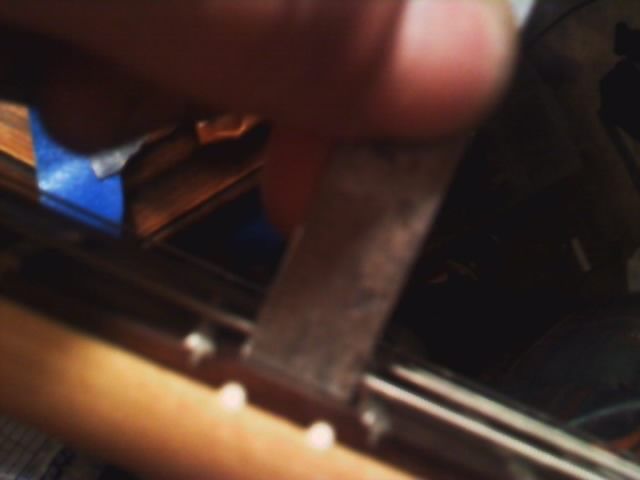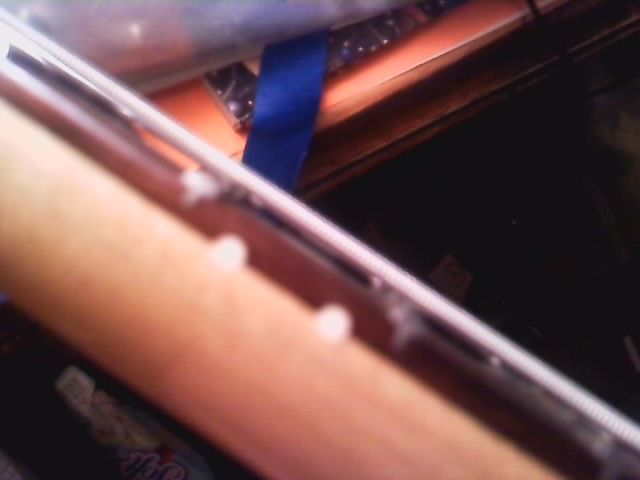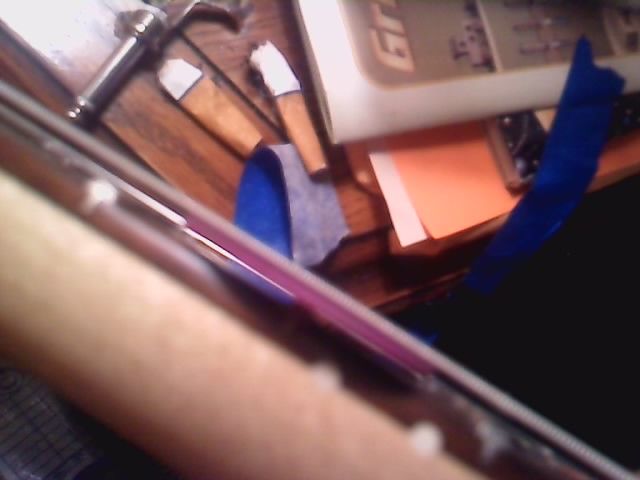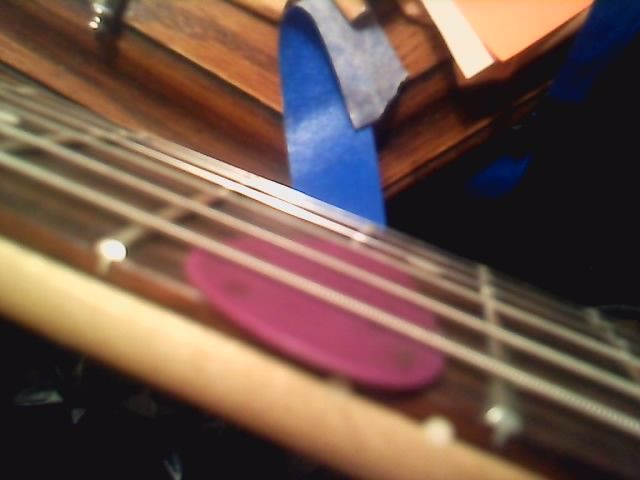truss rod adjustment, the right way, and the wronger way.
Moderated By: mods
- robert(original)
- .

- Posts: 7174
- Joined: Thu Apr 20, 2006 12:30 pm
- Location: somewhere in the midwest
truss rod adjustment, the right way, and the wronger way.
yeah, i said wronger on purpose.
so, I shouldn't have to make this thread, becuz we are shortscale, we don't give a fuck about amber tips and dinky shit, we want to RAWK! and RAWK we shall.
but first! How many people honestly and truly know how to adjust the truss rod in the guitar neck? becuz keeping it perfectly straight or over correcting it still isn't as bad as not doing anything at all.
There has been 3 times that I can recall looking at a members guitar and realizing that they have a certain guage of string or a tuning that required the neck to be adjusted, just to find out that the truss rod was loose and they had never bothered, i suppose they like driving trucks under the strings. J-Mascis was quoted to saying "Your action and be too low, but it can't really be too high" and Dick Dale Prefers high action for optimum string oscillation. But, even then the neck still needs to have a truss rod to counter act the string tension. there is a trick to it.
-For the average everyday player that likes low or medium string height(generally 3-5 mms depending) you need to be able to look down the fretboard,(from the heel to the headstock) and see it be completely straight until it reaches the 3rd fret, then you should see some slight relief. that is perfect for about 90% of playing styles. and the relief should be able to be measure by fretting from the 3rd to the 12th and struming inbetween with no sound being able to... sound. what i mean is that the string should not be able to vibrate between these two frets(when fretted) but if you fret the twelth and strum behind that you should hear a small amount of vibration, not alot, but some. if you fret from the 5th and strum behind that you should also be able to hear a small amount and you should be able to measure in both instances to see the exact amount of relief that you have.
-For the player who likes higher action you still want some tension on your rod(hahahaha) but not as much, instead the relief will be about the 5th-7th fret(depends on scale and truss rod style, compound vs two way, heel vs neck) the relief will be gradual so it will be pretty straight from the heel up to the 7th, then the relief will start, and by the 5th fret you see a nice curve, not too sharp, but enough to add about 1/32 of an inch higher action at the first fret.(don't actually measure all that) anywho. if you do nothing, then you might as well just burn the money you used to buy the guitar, it will be more enjoyable and punk as fuck.
-Even tho all the frets must be the same height(this includes the nut slots) you DO NOT want the neck to be perfectly straight, if it is perfectly straight while strung up and the truss rod counter acting the string tension then you will get weird fret buzz from the first to the third fret(generally, could be more if you over adjust)
this is bad, do not do it.
Rodvonbon has a competition mustang, i believe it to be a 72. anywho. when he got it, someone had either left the truss rod adjusted too much with strings on it, or left it adjusted with string off for many years. this caused a constant arch in the neck, his remedy was to put heavey ass fucking strings on it and tune it really high with the truss rod completely loose, he left it like that for LONG TIME to try and get the neck back to a somewhat useable state. and as far as i know, it worked just fine.
-the opposite of this is when you don't do anything at all to the truss rod and leave it strung up with heavy strings.
this is rather common, imagine this. you go to the music store, you play a guitar, its great! you take it home, and put new strings on it, so you rip off those shitty 8-36 gauge strings and put on your 12-58 gauge strings. all the sudden it doesn't feel like it did, the action is higher and you don't know why, it was awesome at the store right?
well you don't think much of it and before you know it, you have stopped playing it cuz "it doesn't feel right" and three years later you decide to sell it or whatever.
well, since you DID NOT ajust the truss rod to the new gauge of string. the neck has been in a constant bow for three years and getting that bow out can almost be impossible. wood will warp. wood will RARELY EVER warp back to its original state. especially kiln dried stuff thats been treated and retains a higher than normal moisture content(normal moisture is like 7-15% or something stupid like that)
our ole pal aen had a mustang bass. at the store it was FUCKING AWESOME. then he took it home, put on his fav gauge of string and tuned it to his classic style and before he knew it, the action sucked ass. luckily i saw it, gave it the ole 1,2 1,2 action and it was all better, but if he would have left it that way and didn't pay too much mind to it, then it pretty much would have been trashed.
im not pointing to people and saying he or she is dumb, im just giving examples.
PLEASE shortscale, for the love of your guitar, learn to adjust the truss rod properly with the right amount of relief so that it will keep on bringing those sweet sweet RAWK tonez that we all crave.
----some tips----
if you have a painted neck with binding(most acoustics/gibsons) put the butt of the guitar up to your chest and look down the fretboard from the heel to the headstock. use the string as an indication of a mechanically straight line, and folle the binding. you will be able to see the relief and the way the neck curves. I say try it with binding and a painted neck cuz its easier to see as opposed to a one piece maple tele neck with exposed fret ends. it may take you a few guitars and a few weeks or so to really start to know what you are looking at and what to look for. and PLEASE if you have a tech, just ask him some questions or pointers, if he/she isn't a cock nibbler then they should be willing to show you, if not, its time to get a new tech.
thank you all for reading my long winded rant about the truss rod, its not hard. but it is, if you make it so(hahahahaha)
so, I shouldn't have to make this thread, becuz we are shortscale, we don't give a fuck about amber tips and dinky shit, we want to RAWK! and RAWK we shall.
but first! How many people honestly and truly know how to adjust the truss rod in the guitar neck? becuz keeping it perfectly straight or over correcting it still isn't as bad as not doing anything at all.
There has been 3 times that I can recall looking at a members guitar and realizing that they have a certain guage of string or a tuning that required the neck to be adjusted, just to find out that the truss rod was loose and they had never bothered, i suppose they like driving trucks under the strings. J-Mascis was quoted to saying "Your action and be too low, but it can't really be too high" and Dick Dale Prefers high action for optimum string oscillation. But, even then the neck still needs to have a truss rod to counter act the string tension. there is a trick to it.
-For the average everyday player that likes low or medium string height(generally 3-5 mms depending) you need to be able to look down the fretboard,(from the heel to the headstock) and see it be completely straight until it reaches the 3rd fret, then you should see some slight relief. that is perfect for about 90% of playing styles. and the relief should be able to be measure by fretting from the 3rd to the 12th and struming inbetween with no sound being able to... sound. what i mean is that the string should not be able to vibrate between these two frets(when fretted) but if you fret the twelth and strum behind that you should hear a small amount of vibration, not alot, but some. if you fret from the 5th and strum behind that you should also be able to hear a small amount and you should be able to measure in both instances to see the exact amount of relief that you have.
-For the player who likes higher action you still want some tension on your rod(hahahaha) but not as much, instead the relief will be about the 5th-7th fret(depends on scale and truss rod style, compound vs two way, heel vs neck) the relief will be gradual so it will be pretty straight from the heel up to the 7th, then the relief will start, and by the 5th fret you see a nice curve, not too sharp, but enough to add about 1/32 of an inch higher action at the first fret.(don't actually measure all that) anywho. if you do nothing, then you might as well just burn the money you used to buy the guitar, it will be more enjoyable and punk as fuck.
-Even tho all the frets must be the same height(this includes the nut slots) you DO NOT want the neck to be perfectly straight, if it is perfectly straight while strung up and the truss rod counter acting the string tension then you will get weird fret buzz from the first to the third fret(generally, could be more if you over adjust)
this is bad, do not do it.
Rodvonbon has a competition mustang, i believe it to be a 72. anywho. when he got it, someone had either left the truss rod adjusted too much with strings on it, or left it adjusted with string off for many years. this caused a constant arch in the neck, his remedy was to put heavey ass fucking strings on it and tune it really high with the truss rod completely loose, he left it like that for LONG TIME to try and get the neck back to a somewhat useable state. and as far as i know, it worked just fine.
-the opposite of this is when you don't do anything at all to the truss rod and leave it strung up with heavy strings.
this is rather common, imagine this. you go to the music store, you play a guitar, its great! you take it home, and put new strings on it, so you rip off those shitty 8-36 gauge strings and put on your 12-58 gauge strings. all the sudden it doesn't feel like it did, the action is higher and you don't know why, it was awesome at the store right?
well you don't think much of it and before you know it, you have stopped playing it cuz "it doesn't feel right" and three years later you decide to sell it or whatever.
well, since you DID NOT ajust the truss rod to the new gauge of string. the neck has been in a constant bow for three years and getting that bow out can almost be impossible. wood will warp. wood will RARELY EVER warp back to its original state. especially kiln dried stuff thats been treated and retains a higher than normal moisture content(normal moisture is like 7-15% or something stupid like that)
our ole pal aen had a mustang bass. at the store it was FUCKING AWESOME. then he took it home, put on his fav gauge of string and tuned it to his classic style and before he knew it, the action sucked ass. luckily i saw it, gave it the ole 1,2 1,2 action and it was all better, but if he would have left it that way and didn't pay too much mind to it, then it pretty much would have been trashed.
im not pointing to people and saying he or she is dumb, im just giving examples.
PLEASE shortscale, for the love of your guitar, learn to adjust the truss rod properly with the right amount of relief so that it will keep on bringing those sweet sweet RAWK tonez that we all crave.
----some tips----
if you have a painted neck with binding(most acoustics/gibsons) put the butt of the guitar up to your chest and look down the fretboard from the heel to the headstock. use the string as an indication of a mechanically straight line, and folle the binding. you will be able to see the relief and the way the neck curves. I say try it with binding and a painted neck cuz its easier to see as opposed to a one piece maple tele neck with exposed fret ends. it may take you a few guitars and a few weeks or so to really start to know what you are looking at and what to look for. and PLEASE if you have a tech, just ask him some questions or pointers, if he/she isn't a cock nibbler then they should be willing to show you, if not, its time to get a new tech.
thank you all for reading my long winded rant about the truss rod, its not hard. but it is, if you make it so(hahahahaha)
Re: truss rod adjustment, the right way, and the wronger way
5mm is low/medium height? You're doing it wrong.robert(original) wrote:For the average everyday player that likes low or medium string height(generally 3-5 mms depending)
- robert(original)
- .

- Posts: 7174
- Joined: Thu Apr 20, 2006 12:30 pm
- Location: somewhere in the midwest
- robert(original)
- .

- Posts: 7174
- Joined: Thu Apr 20, 2006 12:30 pm
- Location: somewhere in the midwest
pretty close, my phone cant really focus in that well, but i just measured it.


the space from under the string(where contact would be made to the fret) is 2mms almost exactly or 2.5 32nds of an inch. tho, to the fretboard its just under 3mms from the board to the core of the string. my resonator is just slightly higher than that, any lower and it gets a bit too tinny sounding, but expecially with something like a resonator you want big ass string to vibrate the cone and i strum stupid hard.


the space from under the string(where contact would be made to the fret) is 2mms almost exactly or 2.5 32nds of an inch. tho, to the fretboard its just under 3mms from the board to the core of the string. my resonator is just slightly higher than that, any lower and it gets a bit too tinny sounding, but expecially with something like a resonator you want big ass string to vibrate the cone and i strum stupid hard.
- robert(original)
- .

- Posts: 7174
- Joined: Thu Apr 20, 2006 12:30 pm
- Location: somewhere in the midwest
For setting string height/action I usually place a capo at the first fret, then measure at the 17th fret the distance between the top of the fret wire to the bottom edge of the string.
Disciple of Pain
"I'm like the monkey screwing the skunk. I haven't had enough, but I've about had all that I can stand!"
"Born to Lose. Live to Win." Lemmy Kilmister
"I'm like the monkey screwing the skunk. I haven't had enough, but I've about had all that I can stand!"
"Born to Lose. Live to Win." Lemmy Kilmister
- robert(original)
- .

- Posts: 7174
- Joined: Thu Apr 20, 2006 12:30 pm
- Location: somewhere in the midwest
this may be a bit easier, this is a dunlop purple 1.14mm pick, at the twelth fret, stuck under the string, there is just enough space that the string holds it against the fret.


obviously there are different fret sizes and heights so a more accurate way to measure would probly be just the space from the bottom of the string to the top of the fret. which would be just over a mm according to a guitar pick measured 1.14. im sure its not perfect and maybe a bit bigger, or worn down, either way its low, any lower and strumming full chords would become sloppy sounding and your strings wouldn't be able to vibrate enough for a full sound.


obviously there are different fret sizes and heights so a more accurate way to measure would probly be just the space from the bottom of the string to the top of the fret. which would be just over a mm according to a guitar pick measured 1.14. im sure its not perfect and maybe a bit bigger, or worn down, either way its low, any lower and strumming full chords would become sloppy sounding and your strings wouldn't be able to vibrate enough for a full sound.
- robert(original)
- .

- Posts: 7174
- Joined: Thu Apr 20, 2006 12:30 pm
- Location: somewhere in the midwest
Random tip related to truss rods - if you run out of tightening distance, and it stops adjusting the relief, DON'T KEEP TIGHTENING. Two possible outcomes: you will snap the truss rod, or the twist you apply as you tighten too far will turn the anchor at the other end and you will put a twist in the headstock. Instead a washer that fits behind the truss rod nut will give you more adjustment.
True story, I bought a Jazz Bass with a "twisted neck" for cheap which turned out to have this problem. A two cent washer saved me a few hundred bucks because the neck relaxed back to straight after a couple of weeks.
True story, I bought a Jazz Bass with a "twisted neck" for cheap which turned out to have this problem. A two cent washer saved me a few hundred bucks because the neck relaxed back to straight after a couple of weeks.
- robert(original)
- .

- Posts: 7174
- Joined: Thu Apr 20, 2006 12:30 pm
- Location: somewhere in the midwest
i tried something like that with an old villager neck i had, but not only was it bowed completely, but the headstock itself had warped forward, the truss rod was indeed broken, but part of the problem with that neck was it had some birdseye sort of figure, but only on about half of the neck. i was able to practice taking out fret thru the side with it tho, and i kept the inlay dots..... i just don't remember where i put them.
- Chris Fleming
- .

- Posts: 507
- Joined: Wed May 08, 2013 8:14 am
- Location: Glasgow
Never go for a straight neck myself. Usually I have my guitars set up so they have a slight forward bend. Mostly this means not really engaging the truss rod much, only a little for stiffness. Also having the trussrod nut at the bottom, like on my jag is a total pain, so rather than readjusting it every time the weather changes I tend to just leave the action a little high. Might have a bit of an adjustment next I swap the strings, but elixirs last for ages... so not soon
Capo on the 1st & press down near the ass of the neck on the bass E string. I measure from the top of the fret to the bottom of the bass E string in the middle somewhere.
Instead of using a feeler gauge... I use guitar strings, 9, 10, 11, 12, 13 to measure the gap. I drill a hole through a block of wood and pass all the different gauges through it, it acts as a feeler gauge. Faster then using a feeler gauge.
Instead of using a feeler gauge... I use guitar strings, 9, 10, 11, 12, 13 to measure the gap. I drill a hole through a block of wood and pass all the different gauges through it, it acts as a feeler gauge. Faster then using a feeler gauge.
Nice article, thanks for writing it.
My favorite truss rod resource:
http://www.fender.com/support/articles ... tup-guide/
Neck Radius Relief
7.25" .012" (0.3 mm)
9.5" to 12" .010" (0.25 mm)
15" to 17" .008" (0.2 mm)
Neck Radius String Height Bass Side Treble Side
7.25" 5/64"(2 mm) 4/64" (1.6 mm)
9.5" to 12" 4/64" (1.6 mm) 4/64" (1.6 mm)
If you have a Harbor Freight near you they have a set of feeler gauges for $5.
My favorite truss rod resource:
http://www.fender.com/support/articles ... tup-guide/
Neck Radius Relief
7.25" .012" (0.3 mm)
9.5" to 12" .010" (0.25 mm)
15" to 17" .008" (0.2 mm)
Neck Radius String Height Bass Side Treble Side
7.25" 5/64"(2 mm) 4/64" (1.6 mm)
9.5" to 12" 4/64" (1.6 mm) 4/64" (1.6 mm)
If you have a Harbor Freight near you they have a set of feeler gauges for $5.


